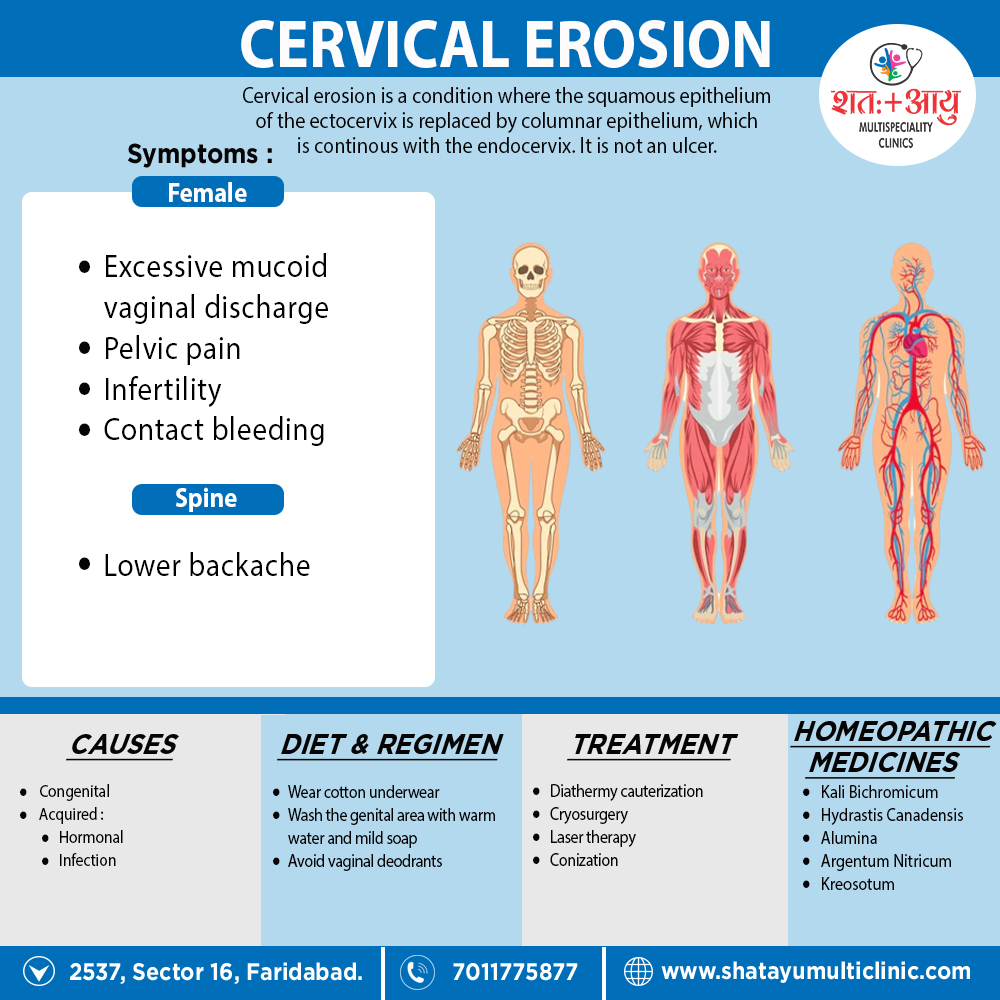Homeopathic Treatment of Cervical Erosion (Cervical Ectopy)
Homeopathy treats the person as a whole. It means that homeopathic treatment focuses on the patient as a person, as well as his pathological condition. The homeopathic medicines selected after a full individualizing examination and case-analysis.
which includes
- The medical history of the patient,
- Physical and mental constitution,
- Family history,
- Presenting symptoms,
- Underlying pathology,
- Possible causative factors etc.
A miasmatic tendency (predisposition/susceptibility) also often taken into account for the treatment of chronic conditions.
What Homoeopathic doctors do?
A homeopathy doctor tries to treat more than just the presenting symptoms. The focus is usually on what caused the disease condition? Why ‘this patient’ is sick ‘this way’?.
The disease diagnosis is important but in homeopathy, the cause of disease not just probed to the level of bacteria and viruses. Other factors like mental, emotional and physical stress that could predispose a person to illness also looked for. No a days, even modern medicine also considers a large number of diseases as psychosomatic. The correct homeopathy remedy tries to correct this disease predisposition.
The focus is not on curing the disease but to cure the person who is sick, to restore the health. If a disease pathology not very advanced, homeopathy remedies do give a hope for cure but even in incurable cases, the quality of life can greatly improved with homeopathic medicines.
Homeopathic Medicines for Cervical Erosion (Cervical Ectopy)
The homeopathic remedies (medicines) given below indicate the therapeutic affinity but this is not a complete and definite guide to the homeopathy treatment of this condition. The symptoms listed against each homeopathic remedy may not be directly related to this disease because in homeopathy general symptoms and constitutional indications also taken into account for selecting a remedy, potency and repetition of dose by Homeopathic doctor.
So, here we describe homeopathic medicine only for reference and education purpose. Do not take medicines without consulting registered homeopathic doctor (BHMS or M.D. Homeopath).
Medicines:
Kali Bichromicum:
- Nymphomania; during puerperal state.
- Moreover, Sterility from excessive sexual indulgence.
- Ovarian neuralgia from ungratified sexual desire.
- Cystic tumours of ovaries.
- Flooding in young women, with sexual desire.
- Menorrhagia, from strong sexual desire.
- Besides, Subinvolution.
- Sexual feeling lost, aversion to coition.
- Lastly, Aggravation Sexual excess, Puberty, Unsatisfied sexual desire.[4]
Hydrastis Canadensis:
- Erosion of cervix.
- Thick; acrid, yellow; ropy leucorrhoea.
- Pruritus vulvae, with profuse leucorrhoea, with sexual excitement.
- Cancer of breast, nipples, retracted, sore, cracked, in nursing women.
- Menorrhagia and metrorrhagia, with fibroids.
- Removes the tendency to habitual adherent placenta.
- Vagina sore, during coition, bleeding after.
- Pain in breast (especially, right) on sneezing.
- Hot, watery, discharge from uterus. [4]
Alumina:
- Menses, too early, short, scanty, pale followed by great exhaustion.
- Leucorrhoea; acrid profuse, runs to feet, worse during daytime; before menses better by washing with cold water.
- Intolerable bearing down pain.
- Tickling and itching in genitals; with strong desire for embrace.
- Nipples itch, burn, looks angry (especially, during pregnancy).
- It takes a woman all her time to recuperate from one menstrual period to the next. [4]
Argentum Nitricum:
- Coition painful, followed by bleeding.
- Prolapsus, with ulceration of os or cervix uteri.
- Metrorrhagia, with nervous erethism at the change of life; also of young widows and childless women.
- Ovaries painful, with pains radiating to sacrum and thighs.
- Menses; irregular, too soon, too late or last one day only.
- Pain in stomach and spasmodic contraction in chest before menses.
- Menses scanty, with Dyspnoea.
- Infants die early after delivery.
- Leucorrhoea; profuse, with erosion of cervix. [5]
Kreosotum:
- Menses; profuse, lumpy; intermittent; worse lying; better sitting, or walking.
- Leucorrhoea, gushing, like bloody water, offensive, corrosive, causing itching, staining the linen yellow; with accompanying complaints; white, having odours of green corn.
- Violent pain during coition; burning in parts, followed by discharge of dark blood; next day.
- Violent itching of vulva and vagina worse during urination. Lochia, lumpy, offensive, intermits.
- Cancer, erosion of cervix.
- Dwindling of mammae with small hard painful lumps in them.
- Menses worse lifting, over exertion.
- Stitches in vagina, make her start. [5]

